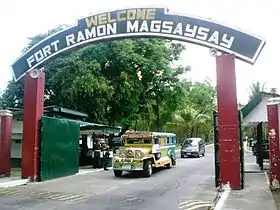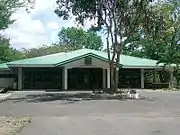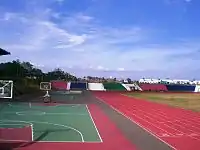Fort Magsaysay
Fort Ramon Magsaysay, also known as Fort Magsaysay Military Reservation (FMMR) and Fort Mag, is the largest military reservation in the Philippines, and is a key training area of the Philippine Army. Fort Magsaysay is located in Nueva Ecija, Philippines.
| Fort Ramon Magsaysay | |
|---|---|
Fort Magsaysay Military Reservation (FMMR) | |
| Nueva Ecija, Philippines | |
 Facade of Fort Ramon Magsaysay | |
.svg.png.webp) Fort Ramon Magsaysay | |
| Coordinates | 15.438°N 121.091°E |
| Type | Military Base |
| Site information | |
| Controlled by | Philippine Army United States Army (under jurisdiction of Enhanced Defense Cooperation Agreement) |
| Site history | |
| Built | December 19, 1955 |
| In use | 1955-present |
| Materials | Concrete, Steel |
| Garrison information | |
| Garrison |
|
Fort Magsaysay Airfield | |||||||||||
|---|---|---|---|---|---|---|---|---|---|---|---|
| Summary | |||||||||||
| Airport type | Military | ||||||||||
| Operator | Philippine Army | ||||||||||
| Location | Fort Ramon Magsaysay, Nueva Ecija, Philippines | ||||||||||
| Elevation AMSL | 75.85 m / 248.85 ft | ||||||||||
| Coordinates | 15°26′02″N 121°05′14″E | ||||||||||
| Map | |||||||||||
.svg.png.webp) RPLV Location of Fort Magsaysay Airfield in the Philippines | |||||||||||
| Runways | |||||||||||
| |||||||||||
Source:[1] | |||||||||||

History
Creation
On December 10, 1955, President Ramon Magsaysay created the 73,000 hectares (180,000 acres) base centered in Laur, Palayan.[2] The reservation covers portions of the provinces of Nueva Ecija, Bulacan, and Aurora. The reservation is to be used for military training and live-fire exercises.
In its infancy Fort Magsaysay hosted the Army Training Command (ATC) which provided basic training for enlisted personnel and officers and advanced training in some specialties such as infantry and artillery.[3]
As one of the main training grounds of the Philippine Army, Fort Magsaysay hosted the Training and Doctrine Command (TRADOC) a couple of times in its history. Currently, TRADOC is located in Camp O'Donnell, but majority of the field exercises are conducted in Fort Magsaysay.
Martial law
During Martial Law, Senators Jose W. Diokno, the father of human rights and Ninoy Aquino, the father of the future 15th Pres. Benigno "Noynoy" Aquino were incarcerated in Fort Magsaysay for exactly thirty days after Marcos declared martial law on September 23, 1972.[4][5]
Recent history
In 1991, Mt. Pinatubo's eruption led to the Philippine government to relocate some of the residents of the volcano and Fort Magsaysay was one of the relocation sites. Almost two decades later, the Philippine Army remains in conflict with tenant farmers, as the latter have been ordered evicted from the military reservation.[6]
Fort Magsaysay's vast tracts of land has time and again attracted a number of claimants, without escaping controversy.[2][7][8] In some occasions, illegal loggers have found their way into the reservation.[9][10]
On September 21, 2012, President Benigno S. Aquino III led the observance of the 40th anniversary by opening the Aquino-Diokno Memorial, the Armed Forces of the Philippines (AFP) Center for Human Rights Dialogue inside Fort Magsaysay and the museum-replica of the 1973 detention facility of Ninoy (Codenamed: Alpha) and Diokno (Codenamed: Delta).
At present, Fort Magsaysay, along with the Crow Valley Range Complex in Pampanga, provides the Armed Forces of the Philippines and allied nations ample training grounds in modern jungle warfare in large unit formation. The RP-US 2009 Balikatan exercises commenced at Fort Magsaysay.[11] The fort is one of the five bases where US troops and supplies could be stationed under a security deal with the Philippine and US governments.[12]
Description
Fort Magsaysay can be reached through the Bangad-Fort Magsaysay Road or through the Sta. Rosa-Fort Magsasay Road.
The original 73,000-hectare military reservation has been reduced to 35,000 hectares after seven presidential proclamations. Despite this reduction, the sprawling base reaches all the way to the Pacific Ocean, over the Sierra Madre Mountains, with 12 kilometers of coastline.[13]
Fort Magsaysay is also the only Philippine Army base that boast its own runway, apron, aircraft maintenance, and air control facilities. The Philippine Army operates Cessna CE172 Skyhawk and CE421 from Fort Magsaysay.
Fort Magsaysay also has its own Rest & Recreation facility called Pahingahan Complex. ("Pahingahan" is the Filipino word for "a place of rest.") The R&R facility is located on the shores of a man-made lake in the base. Soldiers and tourists can also enjoy kayaking and hiking in the nearby trails. Fort Magsaysay is located in Northwest Luzon central of Manila. Its abundance of tropical fruits, vegetation and crops of rice facilitates military personnel among those are chickens used for cockfighting events and food delivery. The choice of transportation are mainly jeepneys, tricycle, motor vehicles and carabao. It is a gateway for rest and lively entertainment.
Modernization
The Department of National Defense's plans to expand and modernize the Philippine Army, Fort Magsaysay has been designated as the AFP's National Training Center (NTC). The NTC's mission is to upgrade and train at battalion level. In a period of 6 years, more than 72 Army Battalions and 12 Marine Battalions have gone through the NTC's program at Fort Magsaysay.[14]
The fort acquired a fleet of trucks and ambulances worth P98.3 million on May 23, 2016.[12]
Facilities
- Fort Magsaysay Airfield(ICAO: RPLV)
- Fort Magsaysay Army Station Hospital (FMASH)
- 650 m firing range
- 500 m firing range
- 150 m firing range
- 100 m firing range
- 1.6 km runway & apron
- Officer's Club
- Batis
- Church
- Headquarters
- Stockade
- Army Store[15]
- R&R Facilities (Pahingahan Complex)
- Aquino Diokno Shrine
- Golf Course
- Pahingahan Dam
- Gym
- AFP Transient Facilities[16]
Gallery
- Fort Magsaysay
 Pahingahan Complex, a rest and relaxation facility on the shores of a man-made lake.
Pahingahan Complex, a rest and relaxation facility on the shores of a man-made lake. Man-made lake in Fort Magsaysay.
Man-made lake in Fort Magsaysay. Facility building in Fort Magsaysay.
Facility building in Fort Magsaysay. Oval Court in Fort Magsaysay.
Oval Court in Fort Magsaysay. Facade of Fort Magsaysay.
Facade of Fort Magsaysay.
See also
References
- Airport information for RPLV from DAFIF (effective October 2006)
- G.R. No. L-27594
- Philippine Army General Structure
- Ninoy's Letter to his daughter Ballsy
- Ninoy's letter to Soc Rodrigo
- Groups bewail eviction of 34 families from military reservation
- Fort Magsaysay in Romblon?
- CA Junks claim over Fort Magsaysay
- Top brass aware of NE logging
- G.R. No. L-24971 June 20, 1975
- Annual Balikatan 2009 exercise at Fort Magsaysay begins
- Domingo, Ferdie (May 23, 2016). "Fort acquires new equipment". The Standard. Retrieved May 28, 2016.
- Multi-Purpose Complex planned by the Army, Philippine Daily Inquirer, June 10, 2000
- PA Photo Release No 01-068 Archived 2010-05-21 at the Wayback Machine
- AFP Transient Facilities and Location Archived 2010-05-23 at the Wayback Machine
External links
| Wikimedia Commons has media related to Fort Magsaysay. |